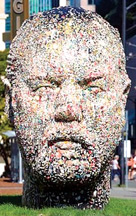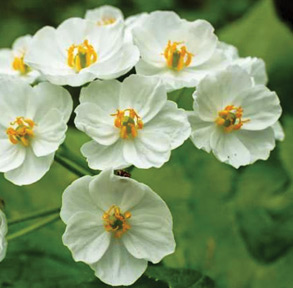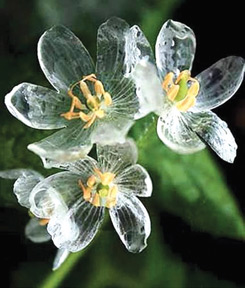|

Africa's little Switzerland
Can you imagine to find lush greenery, cedar and oak forests and
pasturelands in the midst of the hot and dry climate of African
continent?
You'll be surprised when you visit Ifran, a small town in Morocco to
find such a cool place.Ifran is ski resort famous for its European style
and very much similar to the tourist haven of Switzerland. Developed by
the French in the 1930s, Ifrane is so reminiscent of the Swiss Alps that
it is fondly referred to as 'Africa's Little Switzerland'.
 The town is located at an altitude of 5,460 feet above sea level in
the Middle Atlas region. The town is located at an altitude of 5,460 feet above sea level in
the Middle Atlas region.
Its neat red-roofed houses, blooming flower beds, lake-studded parks,
and snowbound winters present a huge contrast to Morocco's narrow, maze
like streets and old, earth-coloured buildings.
The history of Ifrane can be traced back to around 500 B.C. when it
was the capital of an ancient Jewish Kingdom. It was called 'Oufrane'
then, which comes from the Berber language, meaning 'caves'. It is
believed that Jews fleeing from King Nebuchadnezzar found refuge there,
and in later centuries, Arabs and Romans found their way there too.
Soon, Ifrane became an important stop for caravans coming from the
Sahara Desert, carrying goods such as amber, ostrich feathers and other
riches.
During the protectorate era, Ifrane served as an administrative town
for the French government. Just as the concept of 'hill stations' were
developed by the British in India, the French were attracted to Ifrane
for its cool climate during the summer.
They converted the town into an ideal settlement for expatriate
European families - it was designed to make its foreign inhabitants feel
at home. Hence, the architectural style and even the trees and flowering
plants were imported from Europe.
When Morocco gained independence, the locals moved into Ifrane,
infusing it with a bit of their own culture.
They enlarged the town, built a mosque, a public market, and added
other amenities. The prestigious Al Akhawayn University was established
in Ifrane in the mid-1990s. Many of the old chalet houses have been torn
down and replaced with condos. Still, there are plenty of high-pitched
red roofs dotting the town.
Ifrane is easily accessible by road, making it a popular tourist
destination among locals and international tourists. The town boasts of
powdery snow in the winters and cool summers, making it the ideal resort
all year round.
Free of crime and one of the cleanest cities in Morocco, it serves as
the winter playground for the wealthy from the nearby cities of Fez,
Meknes, and Marrakech who go there to ski. For the people of Morocco,
the experience of a European winter is never too far away!
Gumhead - ugly but beautiful art
Chewing gum is banned in some countries as it creates a mess when
irresponsible young people stick their chewed up wads of gum in any
place they choose.
 But for residents and visitors in Howe Street outside Vancouver art
gallery, Canada there is an ideal place to stick their chewed up gum
wads. But for residents and visitors in Howe Street outside Vancouver art
gallery, Canada there is an ideal place to stick their chewed up gum
wads.
It is called "Gumhead" and its a seven-foot fibreglass statue of
Canadian novelist and artist Dougla Coupland who had organised a
colourful and sticky art project in May this year.
He had invited people to stick their chewed up wads of gum on the
head of his fibreglass statue.
The statue aptly called "Gumhead" was part of Coupland's "Everything
is everywhere and anything is everything" exhibition.
By the time the exhibition ended on September first the whole statue
was completely covered in chewing gum. And due to the heat from the
strong sunlight it had all melted resulting in a sweet and sticky mess
that had attracted wasps and bees.
Coupland calling it "ugly and beautiful' said: "I've been everywhere
and I've never seen people interact so intimately and for such a long
time as they do with Gumhead. And people who drive past it every day
like to monitor its progress. It's eight pieces in one: a self-portrait,
a still life, a landscape, social sculpture, performance art, conceptual
art and time-based art. And it wants to be your friend."
Coupland said that he planned to power-wash the statue and then
transport it to Toronto, where the show will repeat in January.
He's excited to know if the gum will stick in a minus-10 environment.
As for a permanent home for Gumhead, he might just put it on the roof of
his house, or make a mold of the whole piece and cast it in bronze.
Rain makes beautiful white flower transparent
You can call this a miracle! It is indeed an unbelievable phenomenon
in the world of nature.
  A beautiful flower with lovely white petals tuns transparent upon
contact with water. A beautiful flower with lovely white petals tuns transparent upon
contact with water.
When it rains, the clusters of lovely blooms of the Diphylleia grayi
magically transform into glistening, crystal-like blossoms. Because of
this amazing phenomenon, the Diphylleia grayi is commonly known as the
'skeleton flower'.
While the plant is perennial and can grow up to a height of 0.4
metres, the flowers bloom from mid-spring to early-summer in shady
conditions.
As the petals of the flowers are soaked in water, they slowly begin
to lose their white pigmentation, turning completely transparent over
time and when dry they return to their original white version.Diphylleia
grayi is a lit tle-known relative of the more popular mayapple (Podophyllum)
and fairy wing (epimedium).
Diphylleia grayi is native to moist wooded mountainsides in colder
regions of China and Japan, where you'll find the large fuzzy green,
umbrella-like, bold foliage topped by small clusters of white, may
apple-like flowers in late spring. While the plant is perennial, and can
grow up to a height of 0.4 metres, the flowers bloom from mid-spring to
early-summer in shady conditions.
As the petals of these flowers are soaked in water, they slowly begin
to lose their white pigmentation, turning completely transparent over
time. In late summer, the stalks of eye-catching cobalt blue fruit
replace the faded flowers.
Diphylleia grayi does not like hot summer temperatures, so plant it
where in a cool moist woodland site. |

